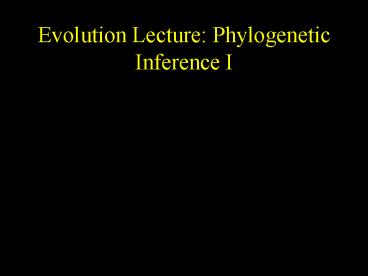Evolution Lecture: Phylogenetic Inference I - PowerPoint PPT Presentation
1 / 19
Title:
Evolution Lecture: Phylogenetic Inference I
Description:
We have focused on how alleles change within populations ... Character states are the different forms of that character (fin, arm, wing) ... – PowerPoint PPT presentation
Number of Views:28
Avg rating:3.0/5.0
Title: Evolution Lecture: Phylogenetic Inference I
1
Evolution Lecture Phylogenetic Inference I
2
Phylogenetics and Population Genetics
- We have focused on how alleles change within
populations - Now we focus on change between populations and
species - Instead of examining differences between
generations we are examining the differences
between species that changed over hundreds or
millions of yearsmacroevolution
3
Phylogenetics
- A phylogeny is a graphical summary of the
evolutionary relationship of taxa or populations - It is a hypothesis
- It shows the sequence of the appearance of
species and documents the relationships of
species - Phylogenies are inferred from data, we do not
have direct evidence for most species
4
Phylogenetic Inference and Questions
- What data do we use to infer phylogenies?
- How do we read trees?
- How do we determine the number of taxa to use?
- How do we know when we have found an accurate
phylogeny - Where do we derive statistical support for a tree?
5
The Logic of Phylogeny Inference
- Inference is not simple and much more involved
than the animals that share the greatest number
of similarities are closely related and those
with greater distance are less related - Characters used to estimate phylogeny should be
independent - Synapomorphies--shared derived traits link
relativesfeathers unite birds b/c their common
ancestors (Dromaeosaurs) had feathers.
Therefore, feathers are a synapomorphy that
define living dinosaursbirds - Synapomorphies are used to join taxa at any
level population, species, genera, families etc
6
Feathered Dinos
7
Synapomorphies
- Define branching points
- When genetic separation occurs, species form, and
homologous traits undergo changes due to mutation
selection or drift - Synapomorphies are nestedas you move through
time and trace a tree from the root, each
branching event adds another derived trait - This describes a hierarchy of branching events
- Cladistics is this field of study and may be most
appropriate for morphological data
8
Character vs. Character State
- A character is a particular attribute of a
specimen (for limb) - Character states are the different forms of that
character (fin, arm, wing) - Synapomorphies join taxa using the derived
homologous states - Symplesiomorphies shared primitive states
- Autapomorphies are advanced character states
found in a singe taxon and do not help resolve
phylogenies
9
Character Matrices
- We can represent characters and states in matrix
form, with taxa, characters and character states
(0,1,2). The states are different between taxa,
even though the same numbers are used. - Taxa 1 2 3
- A 0 0 0
- B 0 0 0
- C 0 1 0
- D 0 1 1
10
Autapomorphy
B
C
A
D
Character 3 Two States
Character 2 Two States
Synapomorphy Uniting Taxa A and B
Synapomorphy Uniting Taxa C and D
Character 1 One state
Synplesiomorphies
11
How do we make trees from data?
- 1) Grouping by overall similarity or grouping by
shared derived characters. - 2) Cladistics believe that evolution proceeds
from primitive to derived, therefore, groupings
should be by shared derived characters - The phylogenies can be very different
12
Example of Different Phylogenetic Groupings
Primitive0 Derived1
Characters 1 2 3 4 5 Taxa A 0
0 0 0 0 B 1 1 0 0 0 C
0 1 1 1 1
Shared Derived
B
C
A
B
A
C
Char 2 State 1
Char 3,4,5 State 0
13
Must Establish which Characters are Homologous
- Homologous traits are found in closely related
groups - We can document this using structure types,
developmental features, and genetic similarities - To establish derived or primitive, we must
understand the polarity of the state - Outgroups analysis, the character state in the
ingroup is compared to the character state in the
outgroup (close relative that branched off
earlier than all of the ingroup taxa) - To determine the appropriate outgroup may be
difficult, but usually involves information from
other phylogenetic hypotheses
14
If Z is the appropriate outgroup, then what would
you expect the States are for the characters?
Primitive0 Derived1
Characters 1 2 3 4 5 Taxa A
1 0 0 0 0 B 1 1 1 0
0 C 1 1 1 1 1
Shared Derived
B
C
A
Z
Char 2,3 State 1
Char 1 State 1
15
(No Transcript)
16
(No Transcript)
17
Homoplasy
- When shared traits are not due to inheritance
from a common ancestor - Flippers in penguins and seals are the result of
homoplasyconvergent evolution - Derived traits can also mutate back to a
primitive formreversals. For example, in DNA, a
A can mutate into an T during a mistake in
replication and unite two taxa, but it can also
mutate back to an A - Convergence and reversals give rise to homoplasy.
Noise in the system. They prevent accurate
reconstruction of phylogeny
18
(No Transcript)
19
(No Transcript)































